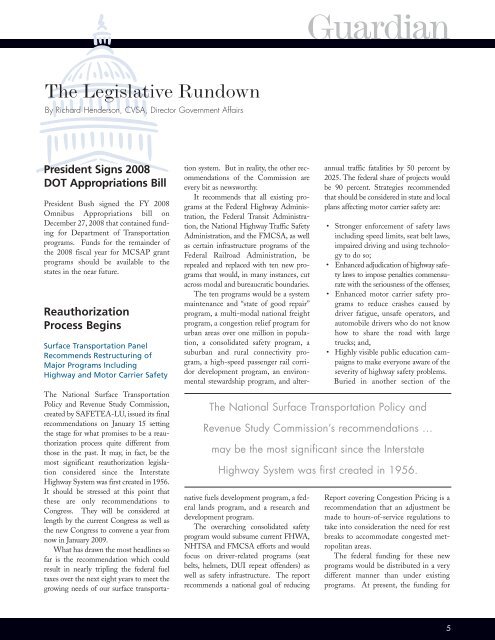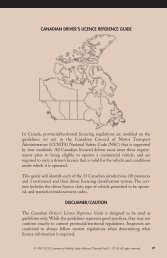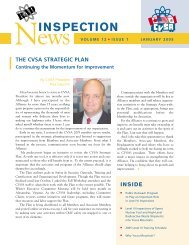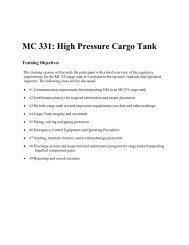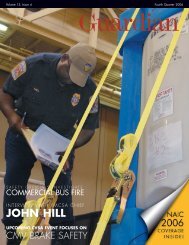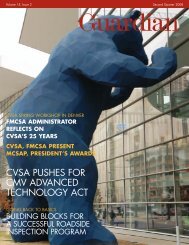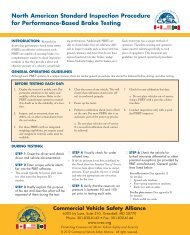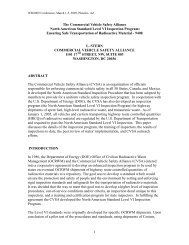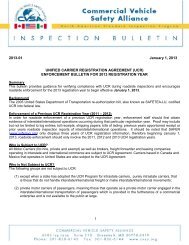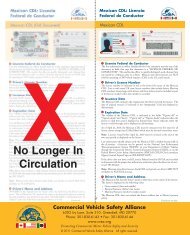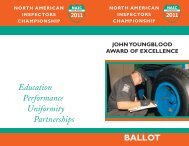inside cover - Commercial Vehicle Safety Alliance
inside cover - Commercial Vehicle Safety Alliance
inside cover - Commercial Vehicle Safety Alliance
You also want an ePaper? Increase the reach of your titles
YUMPU automatically turns print PDFs into web optimized ePapers that Google loves.
Guardian<br />
The Legislative Rundown<br />
By Richard Henderson, CVSA, Director Government Affairs<br />
President Signs 2008<br />
DOT Appropriations Bill<br />
President Bush signed the FY 2008<br />
Omnibus Appropriations bill on<br />
December 27, 2008 that contained funding<br />
for Department of Transportation<br />
programs. Funds for the remainder of<br />
the 2008 fiscal year for MCSAP grant<br />
programs should be available to the<br />
states in the near future.<br />
Reauthorization<br />
Process Begins<br />
Surface Transportation Panel<br />
Recommends Restructuring of<br />
Major Programs Including<br />
Highway and Motor Carrier <strong>Safety</strong><br />
The National Surface Transportation<br />
Policy and Revenue Study Commission,<br />
created by SAFETEA-LU, issued its final<br />
recommendations on January 15 setting<br />
the stage for what promises to be a reauthorization<br />
process quite different from<br />
those in the past. It may, in fact, be the<br />
most significant reauthorization legislation<br />
considered since the Interstate<br />
Highway System was first created in 1956.<br />
It should be stressed at this point that<br />
these are only recommendations to<br />
Congress. They will be considered at<br />
length by the current Congress as well as<br />
the new Congress to convene a year from<br />
now in January 2009.<br />
What has drawn the most headlines so<br />
far is the recommendation which could<br />
result in nearly tripling the federal fuel<br />
taxes over the next eight years to meet the<br />
growing needs of our surface transportation<br />
system. But in reality, the other recommendations<br />
of the Commission are<br />
every bit as newsworthy.<br />
It recommends that all existing programs<br />
at the Federal Highway Administration,<br />
the Federal Transit Administration,<br />
the National Highway Traffic <strong>Safety</strong><br />
Administration, and the FMCSA, as well<br />
as certain infrastructure programs of the<br />
Federal Railroad Administration, be<br />
repealed and replaced with ten new programs<br />
that would, in many instances, cut<br />
across modal and bureaucratic boundaries.<br />
The ten programs would be a system<br />
maintenance and “state of good repair”<br />
program, a multi-modal national freight<br />
program, a congestion relief program for<br />
urban areas over one million in population,<br />
a consolidated safety program, a<br />
suburban and rural connectivity program,<br />
a high-speed passenger rail corridor<br />
development program, an environmental<br />
stewardship program, and alternative<br />
fuels development program, a federal<br />
lands program, and a research and<br />
development program.<br />
The overarching consolidated safety<br />
program would subsume current FHWA,<br />
NHTSA and FMCSA efforts and would<br />
focus on driver-related programs (seat<br />
belts, helmets, DUI repeat offenders) as<br />
well as safety infrastructure. The report<br />
recommends a national goal of reducing<br />
annual traffic fatalities by 50 percent by<br />
2025. The federal share of projects would<br />
be 90 percent. Strategies recommended<br />
that should be considered in state and local<br />
plans affecting motor carrier safety are:<br />
• Stronger enforcement of safety laws<br />
including speed limits, seat belt laws,<br />
impaired driving and using technology<br />
to do so;<br />
• Enhanced adjudication of highway safety<br />
laws to impose penalties commensurate<br />
with the seriousness of the offenses;<br />
• Enhanced motor carrier safety programs<br />
to reduce crashes caused by<br />
driver fatigue, unsafe operators, and<br />
automobile drivers who do not know<br />
how to share the road with large<br />
trucks; and,<br />
• Highly visible public education campaigns<br />
to make everyone aware of the<br />
severity of highway safety problems.<br />
Buried in another section of the<br />
The National Surface Transportation Policy and<br />
Revenue Study Commission’s recommendations …<br />
may be the most significant since the Interstate<br />
Highway System was first created in 1956.<br />
Report <strong>cover</strong>ing Congestion Pricing is a<br />
recommendation that an adjustment be<br />
made to hours-of-service regulations to<br />
take into consideration the need for rest<br />
breaks to accommodate congested metropolitan<br />
areas.<br />
The federal funding for these new<br />
programs would be distributed in a very<br />
different manner than under existing<br />
programs. At present, the funding for<br />
5


